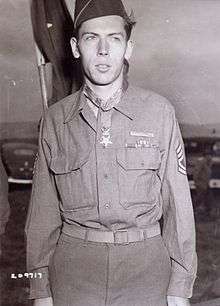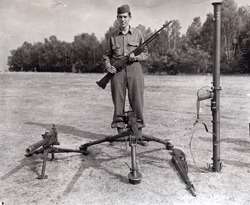Francis S. Currey
| Francis Sherman Currey | |
|---|---|
 Currey wearing his Medal of Honor in 1945 | |
| Born |
June 29, 1925 Loch Sheldrake, New York |
| Allegiance | United States of America |
| Service/branch | United States Army |
| Years of service | 1943 - 1945 |
| Rank | Technical Sergeant |
| Unit | 3rd Battalion, 120th Infantry Regiment, 30th Infantry Division |
| Battles/wars | World War II |
| Awards | Medal of Honor |
Francis Sherman "Frank" Currey (born June 29, 1925) is a former United States Army soldier and a recipient of the United States military's highest decoration—the Medal of Honor—for his actions in World War II.
Biography
Currey was born in Loch Sheldrake, New York, on June 29, 1925. After being orphaned at age 12, he was raised by foster parents on a farm in nearby Hurleyville. He joined the Army in 1943, one week after graduating from high school.[1] Although he completed Officer Candidate School, at only 18 years old his superiors felt that he was "too immature" to be an officer and denied him a commission.[2]
After training with the 75th Infantry Division, Currey was sent to England in the spring of 1944. Due to a recently signed executive order which prevented soldiers under age 19 from entering combat areas, Currey was delayed in England until his birthday at the end of June. He then landed at Omaha Beach, several weeks after D-Day, and in September joined the 120th Infantry Regiment in the Netherlands.[2]

By December 21, 1944, Currey was serving as a Sergeant in Company K, 120th Infantry Regiment, 30th Infantry Division. On that day, in Malmedy, Belgium, Currey repeatedly exposed himself to hostile fire to attack the German forces and rescue five comrades who had been pinned down by enemy fire. He was awarded the Medal of Honor eight months later, on August 17, 1945.[3]
In 1998, a G.I. Joe action figure was modeled after Currey.[1]
Medal of Honor citation
Sergeant Currey's official Medal of Honor citation reads:
He was an automatic rifleman with the 3rd Platoon defending a strong point near Malmedy, Belgium, on 21 December 1944, when the enemy launched a powerful attack. Overrunning tank destroyers and antitank guns located near the strong point, German tanks advanced to the 3rd Platoon's position, and, after prolonged fighting, forced the withdrawal of this group to a nearby factory. Sgt. Currey found a bazooka in the building and crossed the street to secure rockets meanwhile enduring intense fire from enemy tanks and hostile infantrymen who had taken up a position at a house a short distance away. In the face of small-arms, machinegun, and artillery fire, he, with a companion, knocked out a tank with 1 shot. Moving to another position, he observed 3 Germans in the doorway of an enemy-held house. He killed or wounded all 3 with his automatic rifle. He emerged from cover and advanced alone to within 50 yards of the house, intent on wrecking it with rockets. Covered by friendly fire, he stood erect, and fired a shot which knocked down half of 1 wall. While in this forward position, he observed 5 Americans who had been pinned down for hours by fire from the house and 3 tanks. Realizing that they could not escape until the enemy tank and infantry guns had been silenced, Sgt. Currey crossed the street to a vehicle, where he procured an armful of antitank grenades. These he launched while under heavy enemy fire, driving the tankmen from the vehicles into the house. He then climbed onto a half-track in full view of the Germans and fired a machinegun at the house. Once again changing his position, he manned another machinegun whose crew had been killed; under his covering fire the 5 soldiers were able to retire to safety. Deprived of tanks and with heavy infantry casualties, the enemy was forced to withdraw. Through his extensive knowledge of weapons and by his heroic and repeated braving of murderous enemy fire, Sgt. Currey was greatly responsible for inflicting heavy losses in men and material on the enemy, for rescuing 5 comrades, 2 of whom were wounded, and for stemming an attack which threatened to flank his battalion's position.[3]
See also
References
 This article incorporates public domain material from websites or documents of the United States Army Center of Military History.
This article incorporates public domain material from websites or documents of the United States Army Center of Military History.
- 1 2 Bedell, Barbara (July 14, 2006). "Event a tribute to Medal of Honor recipient". Times Herald-Record. Middletown, New York. Retrieved 2012-07-09.
- 1 2 Collier, Peter (2006). Medal of Honor: Portraits of Valor Beyond the Call of Duty. New York: Workman Publishing Company. p. 50. ISBN 978-1-57965-314-9.
- 1 2 "Medal of Honor recipients - World War II (A–F)". United States Army Center of Military History. June 8, 2009. Retrieved 2009-06-09.
External links

Wikimedia Commons has media related to Francis S. Currey.
- "Francis S. Currey". Hall of Valor. Military Times. Retrieved September 13, 2010.